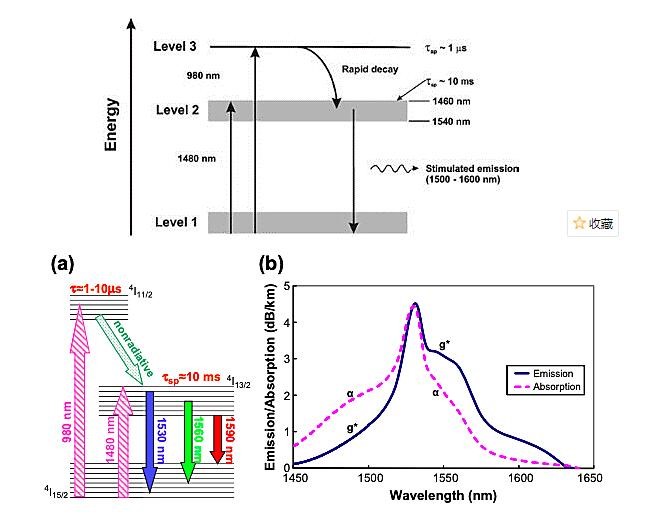
The 980nm 14pin butterfly pump laser produced by Box Optronics uses a TEC cooler and a 980nm Pump laser chip with high performance. Which with high stability, high wavelength accuracy, high fiber output power of more than 600mW and excellent side mode rejection ratio. Box optronics’ pump laser can be used in fiber amplifier, pump light source, fiber sensing system scientific experiment and other fields. At the same time, Box optronics can provide driving circuit to help customers obtain high stability laser light source.
In the field of optical communication, more and more next-generation erbium-doped fiber amplifiers (EDFA) are focusing on how to obtain low-cost, small size and low-power optical amplifiers without affecting performance or reliability.
For example, Bragg grating (FBG) has made great progress in stability. EDFA can obtain Box Optronics’ 600mW ultra-high power 980nm pump in cooled 14PIN butterfly package and Box Optronics’ 200mW 980 nm pump in uncooled mini DIL package. The cost, power consumption and size of the uncooled Box Optronics’ 980nm Pump with mini DIL package are much lower than other types of pump.
The key to obtain an effective and stable FBG wavelength is to keep proper optical feedback into the laser diode cavity. A FP laser diode is actually a TE polarizer. Therefore, only the reflected light of these TE polarizers at the FBG can affect the performance of the diode.
In single-mode pigtails, the deformation of the cellular core is the primary cause of birefringence. The deformation usually occurs in the place where the fiber is bent or twisted during laying, or where any radius of the tail fiber is compressed. Since birefringence can not be completely eliminated, the traditional 980nm pump laser design usually uses high FBG reflectivity to maintain an acceptable single-mode rejection ratio (SMSR) when only a small part of the feedback is TE polarization.
Polarization maintaining fiber is not affected by small disturbance because of its high birefringence. Therefore, the Box Optronics 980nm Pump Module with PMF pigtail similar to FBG length can maintain excellent SMSR in a large dynamic power and temperature range. At the same time, it will increase the production capacity and expand the use of refrigeration and uncooled pumps.
The increasing demand for EDFA with small size and low power consumption is the main driving force to stimulate the rapid development of uncooled pump source. Research shows that once the bulky thermoelectric cooler (TEC) is removed, the power consumption of Box Optronics 980nm Pump module can be reduced by 75%, and smaller and cheaper mini DIL package can be used. Mini DIL is very suitable for the current popular low-cost narrow-band EDFA architecture, which does not require the highest power pump. The platform encapsulated by minidil follows the multi-source protocol and is an extremely standard component. The SMSR can maintain excellent under the condition of power from 24mW to 240mW ,temperature range of -5℃ to 75℃.
However, the uncooled Box Optronics 980nm Pump Laser also increases the test burden. Because the external temperature changes will affect the band spacing of the laser, the quality of the spectrum should be strictly tested in the whole rated temperature and power range. The Box Optronics 980nm Pump cooled by TEC only needs spot tested. Since the 980nm performance of PMF pigtails is fiber lay independent, EDFA assemblers can have confidence in the performance tested in the factory. On the other hand, the uncooled pump laser without PMF should also keep a spare band to ensure satisfactory spectral performance.
The optical calibration technology specially developed for TEC refrigeration environment at 25℃ has been proved to be suitable for higher temperature environment. In order to simulate the reliability in typical working environment (40℃ to 75℃), people have tested the device for millions of hours in the temperature range of 25℃ to 85℃.
In order to be fully adopted, the Ultra-High Power 980nm Pump module must match the dynamic range of the FP 1480nm laser. In detail, the output pump needs to work above the threshold current, which only needs very small amplification. The power dynamic range of the traditional Box Optronics 980nm pumping technology is 15dB (12mW to 350mW), while the 980nm pumping technology with PMF pigtail is more than 20dB.
980nm Pump Module with pigtails is widely used. Its higher output power and versatility also affect the development of EDFA in the future. For example, three-stage, dispersion compensated, gain flattened EDFA architecture.
The development of EDFA mainly focuses on the low-cost minidil package in the preamplifier section, which replaces the previous cooling device, and 980nm Pump in the output section. EDFA will have the lowest possible preamplifier cost, and rely on the multiplexer. In the output section, Box Optronics 980nm Pump will produce low noise output power.
The Box Optronics 980nm pumps EDFA’s are widely used in terrestrial systems while 1480nm pumps are used as Remote Optically Pumped Amplifiers (ROPA) in subsea links where it is difficult to put amplifiers.For submarine systems, remote pumping can be used in order not to have to electrically feed the amplifiers and remove electronic parts.Nowadays ,this is used in pumping up to 200km.
The erbium-doped fiber can be activated by a pump wavelength of 980nm or 1480nm but only the second one is used in repeaterless systems due to the lower fiber loss at 1.4 8 mm with respect to the loss at 0.98mm. This allows the distance between the terminal and the remote amplifier to be increased.
In a typical configuration, the ROPA is comprised of a simple short length of erbium doped fiber in the transmission line placed a few tens of kilometers before a shore terminal or a conventional in-line EDFA. The remote EDF is backward pumped by a 1480nm laser, from the terminal or in-line EDFA, thus providing signal gain.


Copyright @ 2020 Shenzhen Box Optronics Technology Co., Ltd. - China Fiber Optic Modules, Fiber Coupled Lasers Manufacturers, Laser Components Suppliers All Rights Reserved.